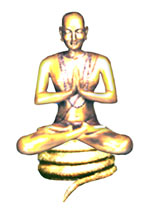 Yoga is one of the gems of acient India. It's history is unique and its benefits are immense. I had a fascination for this "art" since childhood. Initially, it was for the complex poses that I had to strike, but more recently, it has been in trying to study the essence of it.
Yoga is one of the gems of acient India. It's history is unique and its benefits are immense. I had a fascination for this "art" since childhood. Initially, it was for the complex poses that I had to strike, but more recently, it has been in trying to study the essence of it.
Here is some history to digest- In 200 B.C. Indian yogi Patanjali formulates Ashtanga Yoga in his book Yoga Sutra. The Ashtanga Yoga describes 8 paths of yoga:
•Yama (dos)
•Niyama (don'ts)
•Asana (postures)
•Pranayama (breath-control)
•Pratyahara (sense withdrawal)
•Dharana (one-pointedness)
•Dhyana (meditation)
•Samadhi (union with universal consciousness)
As of now, I don't believe I can reach to the level of understanding the final four paths, but I shall try to put some thought in the distant future. Asana is the one that everyone talks about nowadays. Clever marketing spun around imaginative variations has made it a money minting opportunity. Unfortunately, only the Patanjali form of yoga is the true way of performing this art. Each asana had been carefully studied to understand its effects on the human body and mind. Pranayama, is however the most difficult next step . It's something that many of the yoga promoters are not capable of achieving or fail to perform.
•Pranayama has been practiced for centuries by ardent students of Yoga in remote ashrams in India. •Until recently, this art and science of Yogic breathing was almost completely unknown to the common man like many other ancient Indian arts. •The breathing process involves two activities, viz., inhaling (Puraka) and exhaling (Rechaka).
• The state when these two activities are made to halt is given the name "Kumbhaka". The halt after inhaling is called "Abhyantara Kumbhaka" and after exhaling is called "Bahya Kumbhaka".
•It has three variations - Quiet Breathing, Deep Breathing and Fast Breathing. The other methods that form a part of this complex process are Mudras (Symbols) and Bandhas (restrain or hold the energy and dissipate it through the body).
•
This entire regimen is usually practiced in the form of asanas and pranayamas combined with mudras and bandhas. As one can imagine, it requires a lot of patience and a lot of time in one's schedule- Something that cannot be expensed by many.
The combination of these methods provide, in my opinion, one of the greatest control of human beings over body and mind. This is in effect, some of the greater lessons of Hinduism and shall form the story for my analysis of "what makes a nation progressive? what is a developed nation? How do you define it?".
This entire regimen is usually practiced in the form of asanas and pranayamas combined with mudras and bandhas. As one can imagine, it requires a lot of patience and a lot of time in one's schedule- Something that cannot be expensed by many.
The combination of these methods provide, in my opinion, one of the greatest control of human beings over body and mind. This is in effect, some of the greater lessons of Hinduism and shall form the story for my analysis of "what makes a nation progressive? what is a developed nation? How do you define it?".
No comments:
Post a Comment